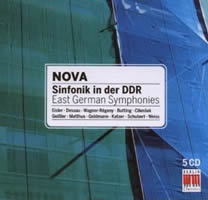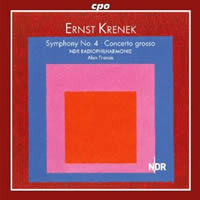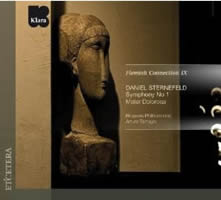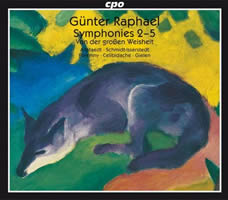Mostly Symphonies 19.
|
Grant Chu Covell [January 2012.]
Paul DESSAU: In memoriam Bertolt Brecht (1957); Symphony No. 2 (1934, 1962); Danse et Chanson* (1937); Examen et poème de Verlaine† (1938); Les Voix‡ (1939-43); Symphony No. 1 (1926). Ksenija Lukic*†‡ (sop), Manuela Bress† (alt), Holger Groschopp‡ (pno), Deutsches Symphonie-Orchester Berlin, Roger Epple (cond.). Capriccio 5019 (1 CD) (http://www.capriccio.at/). Distributed in the US by Naxos (http://www.naxos.com/). Despite a US sojourn which included scoring a few Disney films, Dessau remains obscure outside of East Germany, his home from 1948 until his death in 1979. His music can alternate most disconcertingly from high to low. The single-movement First links diverse episodes with a recurring salutation. Dessau demonstrates adroit counterpoint throughout. The symphony leans towards dissonant expressionism except for a Brucknerian central passage. The Second started life as three movements until a mocking Bartókian Bulgarian dance was added decades later, much like graffiti. Danse et Chanson and Examen et poème de Verlaine are recently discovered works from Dessau’s French years (1933-39). The soprano vocalizes in the Spanish-flavored Chanson. Examen and Les Voix both set Verlaine. Les Voix with obbligato piano utilizes the 12-tone method, whereas the other two vocal works flirt with popular genres. Dessau’s rhythmic motives and catchy martial tunes evoke Wozzeck. The stony In memoriam Bertolt Brecht commemorates Dessau’s close friendship with the poet, and comprises a Lament, a March subtitled “Der Krieg soll verflucht sein,” and an Epitaph. Tightly wound, its fraught serial language stands in the same league as Nono’s Composizione per Orchestra No 2 (Diario polacco ’58).
“NOVA: Sinfonik in der DDR.” Hanns EISLER: Fünf Orchesterstücke (1938)1; Kammer-Symphonie (1940)2. Paul DESSAU: In memoriam Bertolt Brecht (1957)3; Meer der Stürme (Orchestermusik Nr. 2) (1967)4. Rudolf WAGNER-RÉGENY: Drei Orchestersätze (1952)5; Einleitung und Ode (1967)6. Max BUTTING: Sinfonie Nr. 9 (1956)7. Johann CILENŠEK: Sinfonie Nr. 4 (1958)8. Fritz GEISSLER: Sinfonie Nr. 2 (1961-63)9. Siegfried MATTHUS: Sinfonie Nr. 2 (1976)10. Friedrich GOLDMANN: Sinfonie Nr. 1 (1972-73)11. Georg KATZER: Konzert für Orchester Nr. 1 (1973-74)12. Manfred SCHUBERT: Sinfonie Nr. 1 (1979-82)13. Manfred WEISS: Sinfonie Nr. 3 (1979-80)14. Leipziger Kammermusikvereinigung des Gewandhausorchesters1, 2, Max Pommer1, 2 (cond.). Gewandhausorchester Leipzig3, 9, 13, Paul Dessau3, Václav Neumann9, Kurt Masur13 (conds.). Rundfunk-Sinfonie-Orchester Leipzig4, 8, 11, Herbert Kegel4, 8, 11 (cond.). Berliner Sinfonie-Orchester5, 6, Hans-Peter Frank5, Kurt Sanderling6 (conds.). Rundfunk-Sinfonie-Orchester Berlin7, 12, Franz Konwitschny7, Wolf-Dieter Hauschild12 (conds.). Orchester der Komischen Oper Berlin10, Siegfried Matthus10 (cond.). Staatskapelle Dresden14, Herbert Blomstedt14 (cond.). Berlin Classics 0184502BC (5 CDs) (http://www.edelclassics.de/). Distributed in the US by Allegro Music (http://www.allegro-music.com/). Would the GDR have wanted us to hear something quintessentially East German across all these pieces? If there’s any common characteristic, it’s that they’re all somber and angular, hovering between Romantic free atonality and chapter-and-verse serialism. The most familiar outside this collection, Eisler and Dessau are worth getting to know better. Eisler’s Chamber Symphony adds electric keyboards to the small orchestra. A student of Reznicek and Schreker, Wagner-Régeny was a prolific opera conductor, well-regarded in the DDR and teacher to several others here: Goldmann, Katzer, Matthus, Schubert and Weiss. He apparently taught Schoenberg’s principles in secret. The Three Pieces and the more substantial Introduction and Ode strike as anachronistic and measured, as if his modus operandi was to pointedly refer to the past. I would be hard pressed to recognize Butting, Cilenšek, Geissler and Weiss, whose grouchy atonality proved tiring. Matthus’ Second demonstrates more anger but it too blends into the paneling. There’s a subtle shift after 1970, as if everyone gave up trying to be the East German Mahler. Perhaps influences from Poland and France filtered across the border as more pronounced aleatoric touches appear. Goldmann and Katzer warrant further exploration, in fact Katzer has already come into focus. Both works are dynamic, powerfully rhythmic and unapologetic. Goldmann’s First leans towards Webern, Katzer’s Concerto is completely unpredictable.
Ernst KRENEK: Symphony No. 4, Op. 113 (1947); Concerto Grosso No. 2, Op. 25 (1924). NDR Radiophilharmonie, Alun Francis (cond.). cpo 777 210-2 (1 CD) (http://www.cpo.de/). Distributed in the US by Naxos (http://www.naxos.com/). The career of the “degenerate” Jonny spielt auf composer touched multiple countries and styles. Here we find works from America and the Continent. Among Krenek’s five symphonies, No. 4 went missing until recently. This recording’s press material insists the Fourth, completed in 1947 for a premiere under Mitropoulos and the New York Philharmonic in November of the same year, resurfaced in 2007, even though the disc indicates a 2006 recording session. Regardless, cpo now completes its Krenek symphonies series. In three movements, Krenek banters with atonality, more limber than Schoenberg but significantly less distinctive. Bright moments suggest the paths Sessions and Gerhard would take; otherwise there’s little evidence of personality. Riddled with false stops and starts, the last movement will confound despite Francis’ confidence. Written in the year of his short-lived marriage to Anna Mahler, the Concerto Grosso sports stony Neo-classicism. I half expected a chanteuse to jump out from the opening bars, à la Hindemith or Weill. A string trio took center stage instead.
Daniel STERNEFELD: Four Interludes and Finale from Mater Dolorosa (1935); Symphony No. 1 in C major (1943); Elegy: Paraphrase on Kol Nidrei (1931); Variations on “Frère Jacques” (1954). Brussels Philharmonic, Arturo Tamayo (cond.). Etcetera KTC 4029 (1 CD) (http://www.etcetera-records.com/). Distributed in the US by Allegro Music (http://www.allegro-music.com/). Sternefeld’s conducting career at the Royal Flemish Opera ended when the Nazis rolled into Belgium. In hiding he penned his First which had its premiere on Christmas after the 1944 liberation. The symphony opens with a memorable accelerating brass gesture — a cornered animal seeking escape. The three movements culminate optimistically. Sternefeld extracted five contrasting bits from his anti-war opera Mater Dolorosa, completed when he was 29. Like Berg, he fused Romanticism with atonality, comfortable releasing a tonal theme when effective. Two variation sets span Sternefeld’s career: The moody Kol Nidrei variations and the lighthearted Brother Jack variations for brass and percussion.
Günter RAPHAEL: Symphony No. 2, Op. 34 (1932)1; Symphony No. 3, Op. 60 (1942)2; Symphony No. 4, Op. 62 (1947)3; Symphony No. 5, Op. 75 (1952)4; Chorsymphonie “Von der großen Weisheit” nach den Worten des Laotse, Op. 81 (1956)5. Cvetka Ahlin5 (alt), Raimund Grumbach5 (bar). MDR Sinfonieorchester1, 2, Christoph Altstaedt1, Matthias Foremny2 (conds.). Berliner Philharmoniker3, Sergiu Celibidache3 (cond.). NDR Sinfonieorchester4, Hans Schmidt-Isserstedt4 (cond.). Chor des Bayerischen Rundfunks5, Symphonieorchester des Bayerischen Rundfunks5, Michael Gielen5 (cond.). cpo 777 563-2 (3 CDs) (http://www.cpo.de/). Distributed in the US by Naxos (http://www.naxos.com/). Cpo groups five of Raphael’s symphonies, digging up historic recordings and presenting two newish takes. Raphael, fortunate to have survived the Nazis, spent the postwar years rebuilding a career. His postwar Romanticism can be labyrinthine, however, and even as historical documents, these recordings won’t be for everyone. The symphonies are not packaged chronologically: 2 precedes 5, 3 pairs with 4, and the 72-minute choral symphony stands alone. Cpo ignores a 1926 First written when the composer was 23. The Second (rec. in 2007) bursts forth from the Beethoven-Mahler tradition. Immensely likeable, its five movements follow an affirmative path, stopping off at an emotional Adagio and perky scherzo before charging towards a jubilant finale. The 1942 martial Third (rec. in 2003) soon meanders with a fugato returning to first principles. Following an impassioned slow movement, a scherzo becomes frivolous. Is this a war symphony or something else? A slow finale starts regally, recalling the first movement, though the coda’s sprint to the finish suggests unfinished business. This Fourth was recorded in 1950. A polytonal background obscures the first movement’s first theme which contrasts enormously with the subsequent theme’s tonal lyricism. Raphael’s energetic scherzos are usually his most effective movements. As in Nos. 2 and 3, the finale lunges optimistically. Granitic tuttis alternate with jocular soli passages all over the 1952 Fifth, although the 1960 mono recording sounds as if it was taped through a drinking straw. Employing a 12-tone row, Raphael avoids strict principles. I’d like to hear a fresher take. Disc 3 presents Gielen’s abbreviated version of Raphael’s gigantic choral symphony, “Of the Great Wisdom after Lao Tse.” Sung in German, these 12 movements were recorded in 1965. Raphael apparently found great inspiration in the Eastern texts, permitting chorus and soloists a liquid simplicity curiously unlike the preceding symphonies. Nonetheless, Gielen was on the right track when he shortened this opus. The composer’s daughter, Christine, appears on cpo’s two-disc set collecting some of Raphael’s violin music (777 564-2), including violin duos, sonatas with piano, and the Second Violin Concerto. Despite my misgivings about the symphonies, I’ll seek this out.
Butting, Cliensek, Dessau, Eissler, Geissler, Goldmann, Katzer, Krenek, M Schubert, M Weiss, Matthus, Raphael, Sternefeld, Wagner-Regeny
[More Grant Chu Covell, Mostly Symphonies]
[More
Butting, Cliensek, Dessau, Eissler, Geissler, Goldmann, Katzer, Krenek, M Schubert, M Weiss, Matthus, Raphael, Sternefeld, Wagner-Regeny]
[Previous Article:
Spun of Celestial Shimmers]
[Next Article:
History Lessons: Nixon and Gandhi visit the MET]
|




